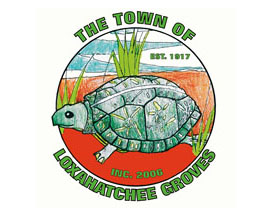The Loxahatchee Groves Town Council gave final approval Tuesday, Jan. 7 for modifications to the Groves Town Center site plan, which will include a retention pond that could serve as a model for how the town resolves water conservation and water quality issues that could arise as the result of federal regulations.
Attorney Matthew Barnes, representing developer Loxahatchee Equestrian Partners, explained that they were before the council three weeks ago asking for preliminary approval, which was granted for the 90-acre site at the northeast corner of B Road and Southern Blvd.
The preliminary approval included requests from the council for further modifications, including the removal of an access point to property to the north on B Road, the addition of a berm on the northern boundary adjacent to some property owners, and a water retention and conservation plan.
“We did receive an updated boundary from the South Florida Water Management District on the large wetland area in the undevelopable portion,” Barnes said.
Bradley Miller with Miller Land Planning, representing the developer, said one of the issues brought up at the last meeting was the master drainage plan and the northern area in the conservation easement on the site, explaining that he had met with the town’s engineering consultant, Randy Wertepny, who had brought up the importance of having a master water conservation plan.
Miller clarified that the proposed water retention area was not a lake, but a restoration area that would have the capacity to circulate and clarify water from the adjacent Collecting Canal.
“It’s more of a water quality thing to work in conjunction with Collecting Canal for the town’s drainage system,” he said. “That area, before it’s permitted, will come back to you.”
A six-foot berm with trees at the north end of Pod G, where a senior living community is proposed, south of the water retention area would serve as an additional buffer for residents north of Collecting Canal.
Wertepny explained that about two years ago, Mary McNicholas, the town’s legislative consultant, began looking into grants that might be available for water conservation projects.
“She was coming up with a water resiliency grant and asked us if there is any opportunity that would actually work well for this within the town,” he said. “We pointed out this actual location, where they are talking about having this project because it is a place adjacent to Collecting Canal.”
Wertepny said most of the surface water in town comes through Collecting Canal at that point, before it discharges through the D Road Canal to the C-51 Canal along Southern Blvd.
“There are not many places in the town for water quality improvements,” he said. “There are not a whole lot of lakes that are publicly owned. There are the privately owned lakes, so we were looking for places to provide water quality treatment and water recharge. This area was selected because it was already cleared. The thought came to, how can we create something that would benefit both parties? The developer could use it for storage. They are required by [the SFWMD] to provide compensating storage. We’re looking for something that can help with water quality improvements for the town.”
Wertepny explained that the area would provide very shallow water retention that could accommodate landscaping and provide filtration for untreated canal water.
“The final plan hasn’t been formulated,” he said. “That’s why the condition that we recommend including brings that plan back for council approval so the council can see what is actually going to be placed there.”
Councilwoman Lisa El-Ramey asked how the retention area will interact with Collecting Canal. Wertepny said the final plan has not been developed, but the intent would be to allow Collecting Canal water to circulate within the retention area, whether by widening the canal or through culverts that would direct water into and out of the retention area.
“We would actually have plants that could remove nutrients from the surface water,” he said, explaining that the developer could also use the retention area for surface water discharge, although there are other water retention areas within the site that would be able to handle all the site’s surface water discharge.
Wertepny added that the water retention area could also provide water to the town in the dry season in lieu of running the town’s back pump so often.
El-Ramey asked if the town is required to have the stormwater retention capacity, and Wertepny said the town is not currently required to have it, but with 2020 Census data, the U.S. Department of Environmental Protection is likely to re-enact water quality requirements that the Loxahatchee Groves Water Control District fought successfully in recent years.
“Having more opportunity for surface water throughout the town allows more water to actually penetrate into the ground and recharge the ground water, so the more opportunities you have to have surface water, it helps with the recharge,” Wertepny said. “The benefit that I think would most benefit the town is filtering the water out of Collecting Canal. That is something the town is going to be challenged with as far as nitrogen and phosphorus removal. This gives you an opportunity to have some land to work with and filter some of that.”
El-Ramey said the proposed retention area is just a speck in the proportion of water that flows through the town that needs to be treated, but Wertepny said the town has less than that to work with now, and approval of the project could serve as a model for future approvals.
He pointed out that the Palm Beach State College tract still has a large portion of undeveloped land with ponds already on it, and there are other undeveloped sites that could be approved with water quality conditions placed upon them.
Maniglia made a motion to approve the Groves Town Center amendments with conditions including the water retention area, which carried 5-0.





